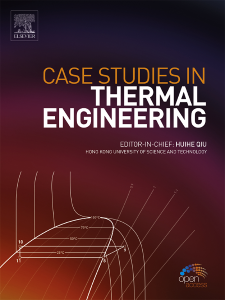阳极支撑型固体氧化物燃料电池热启动过程的内部温度预测和控制策略设计
IF 6.4
2区 工程技术
Q1 THERMODYNAMICS
引用次数: 0
摘要
阳极支撑型固体氧化物燃料电池(SOFC)能量效率高,但启动等瞬态性能较差。本研究提出了一种基于模型的设计方法,为阳极支撑型固体氧化物燃料电池(AS-SOFC)的快速热启动制定合适的策略。首先,建立了 25 千瓦 SOFC 系统的数学模型,并对内部温度进行了预测。随后,比较了热启动过程中的三种不同策略。结果表明,当后燃器和阴极的氢气和空气流量固定时,正电解质-负极(PEN)温度变化幅度为 50 K,响应时间为 1300 s。如果采用 PID 控制器来调节后燃烧器的氢气流量,则 PEN 温度变化幅度会减小到 16 K,响应时间也会缩短到 158 秒;如果同步增加空气流量,则 PEN 温度变化幅度仅为 8 K,与之前的策略相比,分别降低了 84% 和 50%。此外,在第三种控制策略下,后燃烧器排出的气体温度也显著下降。因此,AS-SOFC 的使用寿命和可靠性得到了提高。这些结果为 SOFC 系统控制提供了参考,如家用热电联产(CHP)和移动应用。本文章由计算机程序翻译,如有差异,请以英文原文为准。
Internal temperature prediction and control strategy design of anode-supported solid oxide fuel cell for hot start-up process
Anode-supported solid oxide fuel cell (SOFC) has a high energy efficiency while suffering from a poor transient performance such as start-up. In this study, a model-based design method is proposed to develop a suitable strategy for the rapid hot start-up of anode-supported SOFC (AS-SOFC). First, a mathematical model is established for a 25-kW SOFC system and the internal temperature is predicted. Subsequently, three different strategies are compared during hot start-up process. The results indicate that the positive-electrolyte-negative (PEN) temperature variation magnitude is 50 K and the response time is 1300 s when the hydrogen and the air flow rates are fixed for the afterburner and the cathode. If a PID controller is employed to regulate the flow rate of H2 to the afterburner, the PEN temperature variation magnitude decreases to 16 K with a shorter response time of 158 s. When increasing the air flow rate synchronously, the PEN temperature variation magnitude is merely 8 K, reduced by 84 % and 50 % compared with the previous strategies. Additionally, the gas temperature exiting from the afterburner declines significantly for the third control strategy. Thus, the lifetime and reliability of AS-SOFC is enhanced. The results provide a reference for the SOFC systems control such as domestic combined heat and power (CHP) and mobile applications.
求助全文
通过发布文献求助,成功后即可免费获取论文全文。
去求助
来源期刊

Case Studies in Thermal Engineering
Chemical Engineering-Fluid Flow and Transfer Processes
CiteScore
8.60
自引率
11.80%
发文量
812
审稿时长
76 days
期刊介绍:
Case Studies in Thermal Engineering provides a forum for the rapid publication of short, structured Case Studies in Thermal Engineering and related Short Communications. It provides an essential compendium of case studies for researchers and practitioners in the field of thermal engineering and others who are interested in aspects of thermal engineering cases that could affect other engineering processes. The journal not only publishes new and novel case studies, but also provides a forum for the publication of high quality descriptions of classic thermal engineering problems. The scope of the journal includes case studies of thermal engineering problems in components, devices and systems using existing experimental and numerical techniques in the areas of mechanical, aerospace, chemical, medical, thermal management for electronics, heat exchangers, regeneration, solar thermal energy, thermal storage, building energy conservation, and power generation. Case studies of thermal problems in other areas will also be considered.
 求助内容:
求助内容: 应助结果提醒方式:
应助结果提醒方式:


